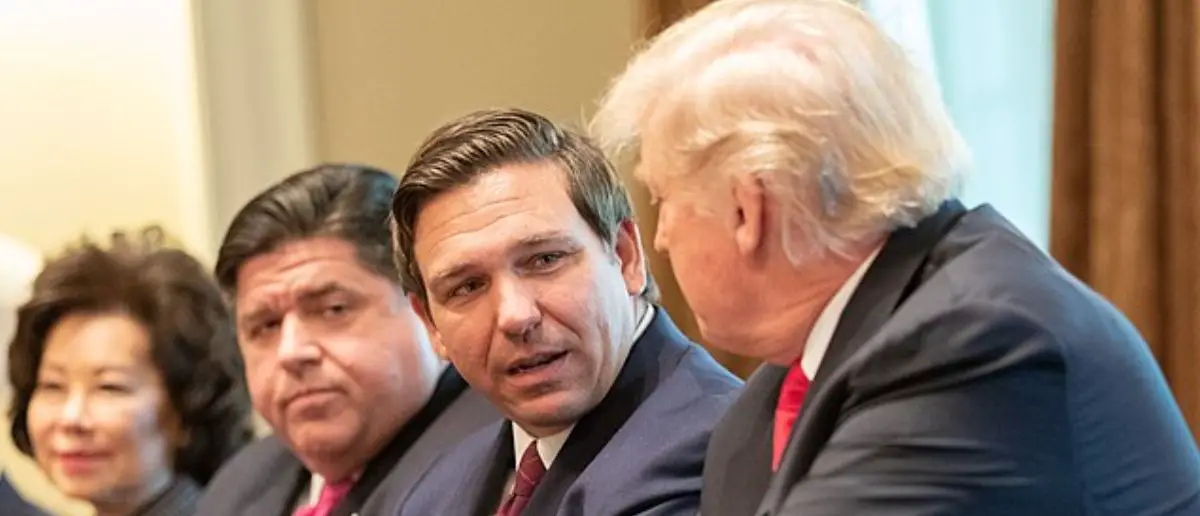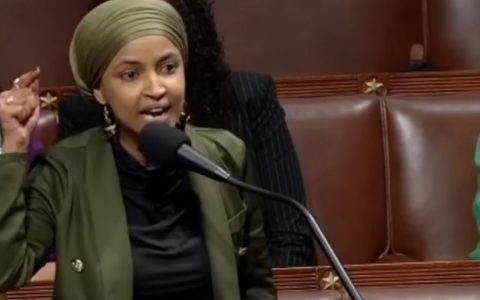
Donald Trump has an odd relationship with other Republicans. Especially the popular governor from Florida.
And now the President’s been given strange news from Florida Governor Ron DeSantis.
It’s not common that you find politicians who are admitting that there needs to be major cuts to government spending in order to improve the economy. It’s even rarer that you find politicians who will actually walk the walk and not just talk the talk. Florida Governor Ron DeSantis has been someone walking the walk for years now in leading the state of Florida.
In Florida, Ron DeSantis has been cutting spending left and right, but that’s not all. He’s also balanced the Florida budget, creating state funding surpluses that have been able to be used to cut taxes for Florida state citizens. Simply put, this is extremely rare for a major, populous state in America. DeSantis is following through on real fiscal responsibility that Americans have been asking for, for years now.
He’s not backing down either, telling the President Trump administration that Florida won’t be accepting federal funding for Florida projects because they carry “too many strings.” He announced this after he met with Elon Musk, who has been heading up the Department of Government Efficiency (DOGE).
DeSantis Announces Returned Federal Funds
Florida Governor Ron DeSantis recently made headlines by announcing that he returned nearly $500 million in federal funds to the U.S. Treasury, citing excessive conditions tied to the money. The two-term Republican governor revealed this decision during an event in Palm Bay on Tuesday, where he also unveiled $389 million in state grants aimed at improving water quality across Florida.
DeSantis explained that the rejected federal funds included $330 million allocated for state projects and $170 million intended for various Florida-based nongovernment organizations. He noted that his initial attempt to return the money occurred during President Joe Biden’s administration, but it wasn’t until a recent discussion with Elon Musk and the U.S. Department of Government Efficiency that the funds were successfully sent back. The governor pointed out that one of the conditions attached to the $330 million grant required the state to monitor tailpipe emissions, a mandate he staunchly opposed.
“It’s rare that states do that because they’re usually like ‘gimme, gimme, gimme,’ but the reality is we all have a role in trying to change the fiscal trajectory of this country,” DeSantis said. “The reality is what we’re doing is unsustainable.”
During the same event, DeSantis detailed the new state-funded water quality initiatives, which include $189 million in Water Quality Improvement grants, $55 million in Alternative Water Supply grants, $100 million for the Indian River Lagoon Protection Program, $25 million through the Caloosahatchee Watershed Grant Program, and $20 million via the Biscayne Bay Water Quality Improvement Grant Program. These investments aim to support restoration efforts and reduce nutrient pollution in Florida’s waterways.
Florida Department of Environmental Protection Secretary Alexis Lambert praised the state’s commitment to these projects. “Florida’s support for water quality projects is making a real impact in reducing nutrient pollution and improving the health of our waterways,” Lambert said at the news conference. “Governor DeSantis and the Legislature have made these investments a priority to provide needed resources for local leaders to take on infrastructure projects that will improve the environment for future generations.”
This year, the Department of Environmental Protection received 348 project proposals totaling $2.2 billion, with state officials approving 31 as top priorities. These initiatives are projected to eliminate 1.1 million pounds of nitrogen and 286,000 pounds of phosphorus from agricultural runoff and other sources that contribute to harmful algae blooms. Specific efforts include 25 water quality projects worth $100 million along the Indian River Lagoon on the Atlantic Coast, four projects in the Caloosahatchee River and estuary in southwest Florida, and eight projects in Biscayne Bay near Miami.
Additionally, 14 projects under the Alternative Water Supply Grant Program have been green-lit, expected to generate 40 million gallons of water per day within two years. These endeavors will enhance reclaimed water usage, recharge Florida’s critical aquifers, and encourage water conservation statewide.
Florida's legacy of strong, conservative leadership has made us the best state in the nation & we've attracted record numbers of new residents.
It's imperative that we work to update & expand transportation networks throughout our state to make travel more seamless & accessible. pic.twitter.com/7NEcHbN0bQ
— Byron Donalds (@ByronDonalds) March 19, 2025
Trump Not Yet Satisfied With Federal Spending Cuts From DOGE
President Donald Trump recently expressed optimism about the progress of the Department of Government Efficiency (DOGE), a new initiative aimed at streamlining the federal government. Speaking at a cabinet meeting on Monday, Trump predicted that within the next two or three months, his administration would be largely content with the efforts of those involved in the project. “We think probably over the next two or three months, we will be pretty much satisfied with the people that are working hard and want to be members of the administration and our country,” he stated.
Trump emphasized the importance of retaining capable employees while eliminating unnecessary or underperforming ones. “We want to keep the good ones, and we want to get rid of the ones that don’t exist, and we want to get rid of the ones that do exist but don’t work, and we have quite a few of them,” he said, referring to federal workers. He acknowledged that DOGE’s mission might not win widespread approval, but he believes it is essential for the nation’s well-being. “What DOGE is trying to do is not necessarily a very popular thing,” Trump admitted, adding, “but I think it has to be done to save our country.”
The president also commented on the public perception of DOGE’s efforts, noting, “I have no idea how it plays out in the public. I guess you see poll numbers that are very good numbers, but I don’t know what that means long-term.” Trump first announced the creation of DOGE in November, appointing Elon Musk, the head of Tesla and SpaceX, and Vivek Ramaswamy to lead the department. Ramaswamy stepped down from his role in January.
Since Trump’s inauguration, DOGE has acted swiftly to reduce federal expenditures, terminating thousands of government employees and closing down various foreign aid initiatives. These extensive reductions, however, have led to significant disruption. The rapid pace and scale of the cuts have left many agencies struggling to adapt, creating operational challenges across multiple sectors.
Legal obstacles have also emerged for Musk and DOGE. Since the beginning of Trump’s second term, the department has faced nearly two dozen lawsuits challenging its actions. Earlier this month, a federal judge mandated that Musk and DOGE provide documentation and respond to inquiries regarding the department’s strategy for downsizing federal agencies. Additionally, courts have directed the Trump administration to reinstate some of the dismissed federal workers, further complicating DOGE’s objectives.
The White House and DOGE have remained silent on these developments, with representatives declining to comment when asked by reporters. As DOGE continues its aggressive push to reshape the federal government, the coming months will likely reveal whether Trump’s vision of efficiency can be realized amid growing resistance and legal scrutiny.
Stay tuned to the DC Daily Journal.





